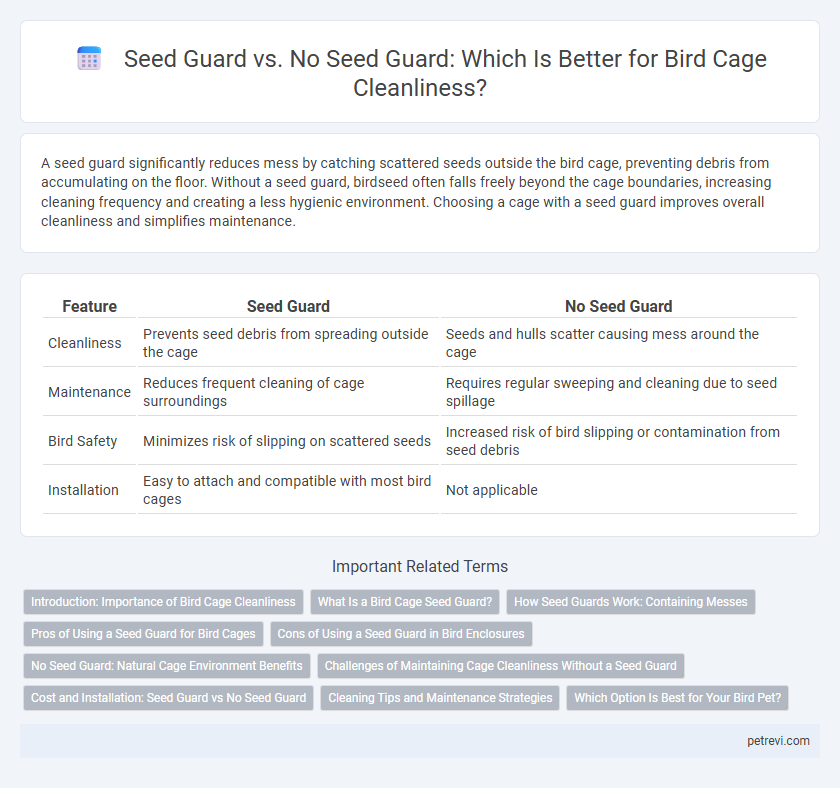A seed guard significantly reduces mess by catching scattered seeds outside the bird cage, preventing debris from accumulating on the floor. Without a seed guard, birdseed often falls freely beyond the cage boundaries, increasing cleaning frequency and creating a less hygienic environment. Choosing a cage with a seed guard improves overall cleanliness and simplifies maintenance.
Table of Comparison
| Feature | Seed Guard | No Seed Guard |
|---|---|---|
| Cleanliness | Prevents seed debris from spreading outside the cage | Seeds and hulls scatter causing mess around the cage |
| Maintenance | Reduces frequent cleaning of cage surroundings | Requires regular sweeping and cleaning due to seed spillage |
| Bird Safety | Minimizes risk of slipping on scattered seeds | Increased risk of bird slipping or contamination from seed debris |
| Installation | Easy to attach and compatible with most bird cages | Not applicable |
Introduction: Importance of Bird Cage Cleanliness
Maintaining a clean bird cage is essential for preventing diseases and promoting the overall health of pet birds. Seed guards play a crucial role in minimizing seed spillage, which reduces debris accumulation around the cage and simplifies cleaning routines. Without seed guards, scattered seeds can attract pests and create unsanitary conditions, posing a risk to both birds and their owners.
What Is a Bird Cage Seed Guard?
A bird cage seed guard is a protective barrier that attaches around the bottom of the cage to prevent seeds and debris from scattering outside, significantly reducing mess and cleaning time. Without a seed guard, seeds often spill onto the floor, leading to frequent sweeping and potential attracting of pests. Using a seed guard enhances cage hygiene and helps maintain a cleaner environment for both the bird and its owner.
How Seed Guards Work: Containing Messes
Seed guards effectively contain messes by creating a barrier around the cage's base, preventing seeds and hulls from scattering outside the cage area. These guards, typically made of durable plastic or mesh, catch debris as the bird feeds, reducing floor cleaning frequency and maintaining a tidier environment. Without seed guards, spilled seeds and waste scatter widely, increasing maintenance time and potentially attracting pests.
Pros of Using a Seed Guard for Bird Cages
A seed guard significantly reduces scattered seeds and debris outside the bird cage, maintaining cleaner surroundings and minimizing daily cleanup. This barrier prevents waste from falling onto floors or furniture, promoting a hygienic environment for both birds and owners. Installing a seed guard also helps preserve room aesthetics and reduces allergens by containing dust and seed hulls within the cage area.
Cons of Using a Seed Guard in Bird Enclosures
Using a seed guard in bird cages can limit airflow and light penetration, potentially affecting bird health and comfort. Seed guards are often cumbersome to clean, trapping debris and leading to mold or bacterial growth if not maintained properly. These guards may also restrict access for thorough cage cleaning, resulting in accumulation of waste and reduced overall hygiene.
No Seed Guard: Natural Cage Environment Benefits
No seed guard cages promote a natural environment by allowing seeds to fall through the bars, reducing moisture buildup and mold growth inside the cage. This natural seed scattering encourages birds to forage and engage in instinctive behaviors, enhancing mental stimulation and overall well-being. The absence of a seed guard simplifies cleaning routines by preventing seed accumulation that can attract pests or cause odor problems.
Challenges of Maintaining Cage Cleanliness Without a Seed Guard
Maintaining cage cleanliness without a seed guard presents challenges such as increased seed spillage, which leads to frequent sweeping and potential buildup of mold or bacteria from damp, decayed seeds. Birds often scatter seeds outside the cage, attracting pests like ants and rodents that compromise hygiene. The absence of a seed guard demands more rigorous cleaning routines and can impact the overall health environment for pet birds.
Cost and Installation: Seed Guard vs No Seed Guard
Installing a seed guard on a bird cage helps contain scattered seeds, reducing cleaning frequency and associated labor costs. While the initial investment for a seed guard can be higher than no seed guard setups, long-term savings arise from minimized seed spillage and waste. No seed guard options often entail lower upfront costs but increase ongoing cleaning time and seed replacement expenses, impacting overall cost efficiency.
Cleaning Tips and Maintenance Strategies
A bird cage with a seed guard significantly reduces seed scatter, minimizing cleaning frequency and maintaining a cleaner environment for birds. Without a seed guard, regular sweeping and vacuuming under the cage are essential to manage seed hulls and debris effectively. Using removable seed guards with smooth surfaces simplifies routine maintenance by allowing easy wiping and prevents buildup of waste around the cage.
Which Option Is Best for Your Bird Pet?
A seed guard on a bird cage effectively contains scattered seeds and debris, reducing cleaning time and maintaining a tidier environment for both the bird and owner. Without a seed guard, seeds often spill outside the cage, increasing mess and potential pest issues, especially for active or messy eaters like parrots or finches. Choosing a seed guard depends on your bird's eating habits and your tolerance for daily cleanup, making it the best option for those seeking cleaner cage surroundings.
Seed guard vs No seed guard for Bird cage cleanliness Infographic

 petrevi.com
petrevi.com